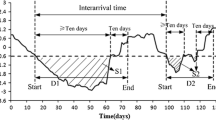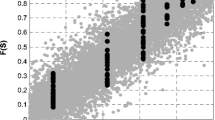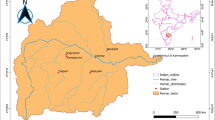Abstract
Changing characteristics of hazardous weather-related events have been arousing considerable public interest in recent years. Guangdong is an economically developed province in China and is prone to natural hazards. Using monthly precipitation data covering a period of 1956–2008 from 127 rain gauge stations, the probabilistic behaviors of SPI-based droughts were investigated with copulas functions. Results indicated a higher risk of droughts along the coastal regions and the western Guangdong, particularly the Pearl River Delta (PRD) region. Joint probabilities of droughts with higher intensity and longer duration were found to have relatively even geographical distribution across Guangdong. The northern parts of Guangdong are higher in altitude and have a lower risk of droughts. Identification of regions characterized by droughts of different severity and durations across Guangdong is important for scientific management of water resource and agricultural activities and also the development of social resilience under the influence of climate changes.




Similar content being viewed by others
References
Bordi I, Fraedrich K, Gerstengarbe F-W, Werner PC, Sutera A (2004) Potential predictability of dry and wet periods: Sicily and Elbe-Basin (Germany). Theor Appl Climatol 77:125–138
Calanca P (2007) Climate change and drought occurrence in the Alpine region: How severe are becoming the extremes? Global Planet Change 57:151–160
Cancelliere A, Salas DJ (2010) Drought probabilities and return period for annual streamflow series. J Hydrol 391:77–89
Chen TG, Zeng X, Zhang JY (2007) Precipitation and drought/flood trends in Guangdong under the background of global warming. Guangdong Meteorol 29(1):5–10 (in Chinese)
Du YD, Liu JL, Song LL (2004) Characteristics and forming causes of drought and its controlling measures in Leizhou peninsula. Agri Res Arid Areas 22(1):28–31 (in Chinese)
Fleig AK, Tallaksen LM, Hisdal H, Demuth S (2006) A global evaluation of streamflow drought characteristics. Hydrol Earth Syst Sci 10:535–552
Ha DK, Chulsang Y, Tae-Woong K (2011) Application of spatial EOF and multivariate time series model for evaluating agricultural drought vulnerability in Korea. Adv Water Resour 34:340–350
Hayes MJ, Svoboda MD, Wilhite DA, Vanyarkho OV (1999) Monitoring the 1996 Drought Using the Standardized Precipitation Index. B Am Meteorol Soc 80:429–438
He HY (1998) Features of dryness and wetness in Guangdong province during a period of nearly 40 years. J Tropic Meteorol 14(4):297–305 (in Chinese)
Hisdal H, Tallaksen ML (2003) Estimation of regional meteorological and hydrological drought characteristics: a case study for Denmark. J Hydrol 281:230–247
Kao S-C, Govindaraju SR (2010) A copula-based joint deficit index for droughts. J Hydrol 380:121–134
Livada I, Assimakopoulos VD (2007) Spatial and temporal analysis of drought in Greece using the Standardized Precipitation Index (SPI). Theor Appl Climatol 89:143–153
Lloyd-Hughes B, Saunders M (2002) A drought climatology for Europe. Int J Climatol 22:1571–1592
Lu XX, Zhang SR, Xie SP, Ma PK (2007) Rapid channel incision of the lower Pearl River (China) since the 1990s as a consequence of sediment depletion. Hydrol Earth Syst Sci 11:1897–1906
McKee TB, Doesken NJ, Kleist J (1993) The relationship of drought frequency and duration to time scales. Preprints Eighth Conf on Applied Climatology Anaheim CA. Am Meteor Soc 179–184
McKee TB, Doesken NJ, Kleist J (1995) Drought monitoring with multiple time scales, Preprints, Ninth Conf Appl Climatol, Dallas, Am Meteorol Soc 233–236
Mishra KA, Singh PV (2010) A review of drought concepts. J Hydrol 391:202–216
Moreira EE, Coelho CA, Paulo AA, Pereira SL, Mexia TJ (2008) SPI-based drought category prediction using loglinear models. J Hydrol 354:116–130
Piao SL, Ciais P, Huang Y, Shen ZS, Peng S, Li J, Zhou L, Liu H, Ma Y, Ding YH, Friedlingstein P, Liu CZ, Tan K, Yu YQ, Zhang T, Fang JY, Piao SL (2010) The impacts of climate change on water resources and agriculture in China. Nature 467:43–51
Serinaldi F, Bonaccorso B, Cancelliere A, Grimaldi S (2009) Probabilistic characterization of drought properties through copulas. Phys Chem Earth 34:596–605
Shiau JT (2006) Fitting drought and severity with two-dimensional copulas. Water Res Manage 20(5):795–815
Shiau JT, Shen HW (2001) Recurrence analysis of hydrologic droughts of differing severity. J Water Res Plan Manage 127(1):30–40
Silva Y, Takahashi K, Chávez R (2007) Dry and wet rainy seasons in the Mantaro River basin (Central Peruvian Andes). Adv Geosci 14:1–4
Wilhite DA (2000) Drought as a natural hazard: concepts and definitions. In: Drought: a global assessment Wilhite DA (Ed.), Routledge, London, pp 3–18
Wilhite DA, Glantz MH (1985) Understanding the drought phenomenon: The role of definitions. Water Inter 10(3):111–120
Wilks DS (1995) Statistical methods in the atmospheric sciences. London, Academic Press
Yevjevich V (1967) An objective approach to definitions and investigation of continental hydrologic droughts, hydrology paper 23. Colorado State University, Fort Collins
Zelenhastic E, Salvai A (1987) A method of streamflow drought analysis. Water Resour Res 23(1):156–168
Zhai PM, Zou XK (2005) Changes of temperature and precipitation and their effects on drought in China during 1951–2003. Adv Clim Change Res 1:16–18 (in Chinese)
Zhang L, Singh VP (2006) Bivariate flood frequency analysis using the copula method. J Hydrol Eng 11:150–164
Zhang L, Singh VP (2007) Bivariate rainfall frequency distributions using Archimedean copulas. J Hydrol 332:93–109
Zhang Y, Wang CL, Luo XL (2000) Climatic causes of drought in Guangdong and its disaster reduction. Trop Geograp 20(1):17–21 (in Chinese)
Zhang Q, Xu C-Y, Chen YD, Yang T (2009a) Spatial assessment of hydrologic alteration across the Pearl River Delta, China, and possible underlying causes. Hydrol Process 23:1565–1574
Zhang Q, Xu C-Y, Zhang ZX (2009b) Observed changes of drought/wetness episodes in the Pearl River basin, China, using the Standardized Precipitation Index and Aridity Index. Theor Appl Climatol 98:89–99
Zhang Q, Jiang T, Chen YD, Chen XH (2010) Changing properties of hydrological extremes in south China: natural variations or human influences? Hydrol Process 24(11):1421–1432
Zhang Q, Zhang W, Chen YD, Jiang T (2011) Flood, drought and typhoon disasters during the last half century in the Guangdong province, China. Nat Hazard, doi:10.1007/s11069-010-9611-9
Acknowledgments
The research is financially supported by the National Natural Science Foundation of China (Grant No.: 41071020; 50839005), the Project from Guangdong Science and Technology Department (Grant No.: 2010B050800001; 2010B050300010)), the Program for Outstanding Young Teachers of the Sun Yat-sen University (Grant No.: 1132381) and by a grant from the Research Grants Council of the Hong Kong Special Administrative Region, China (Project No. CUHK405308). Cordial gratitude should be extended to the editor-in-chief, Prof. Dr. T. S. Murty, and two reviewers for their insightful review and professional comments, which greatly help to improve the quality of this manuscript.
Author information
Authors and Affiliations
Corresponding author
Appendix
Appendix
The Copula family is described as the follows:
-
(1)
Gumbel–Hougaard (GH) family
The GH family can be formulated as:
where u and v are the marginal distribution functions of two hydrological variables; θ is the parameter of GH family; C is the copula having the function of capturing the essential features of the dependence among random variables. Parameters u, v, and θ in the following equations have the same meaning as those in Eq. 13; so, no further explanations are provided thereafter. The copula generator of GH family (Zhang and Singh 2007) is
t is the u 1 or v 1, being specific values of u and v in Eq. 13 varying from 0 to 1. The relationship between the parameter, θ, and the Kendall’s coefficient of correlation, τ, between X and Y is τ = 1 − θ −1. The GH copula performs well in the description of correlation structure of two variables characterized by positive correlation.
-
(2)
Clayton family
The Clayton family can be formulated as:
The copula generator of the Clayton family is
The relationship between the parameter, θ, and Kendall’s coefficient of correlation, τ, between X and Y is
The Clayton family is good at the description of two variables having positive correlation.
-
(3)
Frank family
The Frank family can be formulated as:
The copula generator of the Frank family is
The relationship between parameter, θ, and Kendall’s coefficient of correlation, τ, between X and Y is
The Frank family describes two variables in positive correlation well.
-
(1)
t copula family
The t family can be formulated as:
\( t_{v,R}^{n} \) is the R-dimensional standard t distribution with degree of freedom of v. \( t_{v}^{ - 1} \) is the inverse function of \( t_{v,R}^{n} \).
The relationship between parameter, θ, and Kendall’s coefficient of correlation, τ, between X and Y is
1.1 Conditional copula
Let X and Y be random variables with marginal distributions as u = F X (x) and v = F Y (y). The conditional distribution function of X given Y = y can be expressed by the copula method as
An equivalent formula for the conditional distribution function for Y given X = x can be obtained. The conditional distribution function of X given Y ≥ y can be expressed by the copula method as
Similarly, an equivalent formula for the conditional distribution function for Y given X < x can be obtained.
Rights and permissions
About this article
Cite this article
Liu, CL., Zhang, Q., Singh, V.P. et al. Copula-based evaluations of drought variations in Guangdong, South China. Nat Hazards 59, 1533–1546 (2011). https://doi.org/10.1007/s11069-011-9850-4
Received:
Accepted:
Published:
Issue Date:
DOI: https://doi.org/10.1007/s11069-011-9850-4




